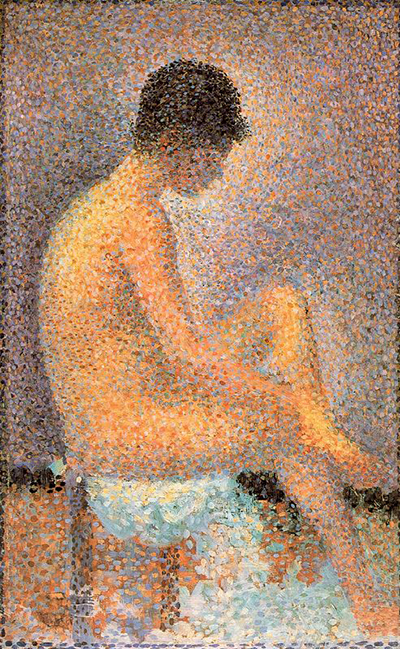George Seurat began working on a large arrangement The Models during the winter of 1886-1887. The painting is now available from the Barnes Foundation, in Merion, USA. It depicts three women in the artist's workshop who pose naked. An afternoon in La Grande Jatte, a manifesto in the modern style in which Seurat became the creator, was replicated on the wall and called Neo-Impressionism by critic Felix Fénéon.
Model in Profile – The Setting
The Models, including three experiments in the Musee d'Orsay, were prepared by Seurat: Model, Side View, Model, Front View & Model, Back view.
The painter shows off his model seated naked from the back on a white sheet in Model, Back View. She makes one recall a famous painting by Jean-Auguste Dominique Ingres that caused a stir when it entered the Louvre in 1879: the Valpinçon Bather. Like Ingres, whom he revered very much, Seurat highlights the head and neck of the woman's back.
Using the technique he had begun himself, Seurat splits the brushstrokes into small points of pure colour, juxtaposed. Félix Fénéon's owned the three models until his death. In 1947 they were acquired by the National Musées together with a pencil sketch of the studio stove; it is now part of the Musee d'Orsay's drawing assemblage.
The Model in Profile is an oil on wood panel painting where the artist studies an additional problem: a light silhouette on a light background. He deepens the light colours on the right thigh, arm, left leg and back curves as the profile lightens round the body front and left shin and knee. In shape and size, the brush marks are distinct, and their directional changes bring forth life.
Inspiration Behind Model in Profile
Seurat was a cultured, widely read guy who understood the art of the past well. He studied the culture of ancient Egypt and classical Roman and Greek sculpture in the Louvre Museum, Paris. For example, the Model in Profile redrafts the iconic Greco-Roman bronze, The thorn-puller. The copy of the 16th century kept at the Louvre was known to Seurat. Here the model plans for work or finishes posing while she draws on a pair of green stockings. Seen from the rear, the model seems to relax, while the upright model in Model standing and Model from the front sits calmly, at work.
Model from the back is one of George's most rewarding contributions of his aesthetic teachings. The pale skin of the woman is rosé in colour, displayed in contrasting orange and blue dots. The colour of the darker background is inverted in yellow, orange, blue, white, and red as she sits on a subtly executed blank sheet. The artist perceives in intricate detail, the gradual fall of light on curved living flesh in detail, not a dogmatic show of complementary colour theories. Seurat acquaints with Jean-Auguste-Dominique Ingres' drawing of the back view of an odalisque. Ingres' nude is turning to face the viewer, seemingly welcoming them into her surreptitious world.




